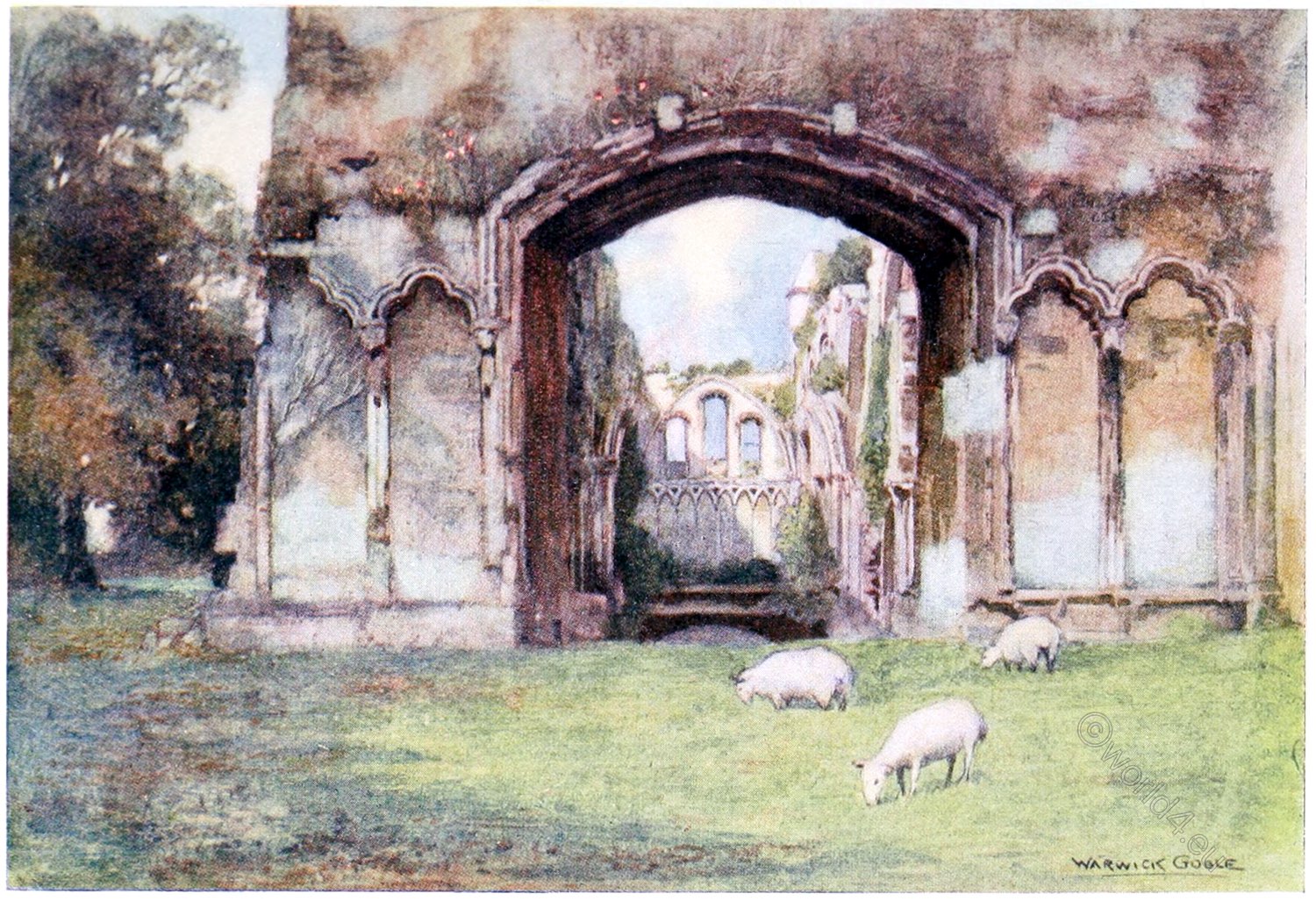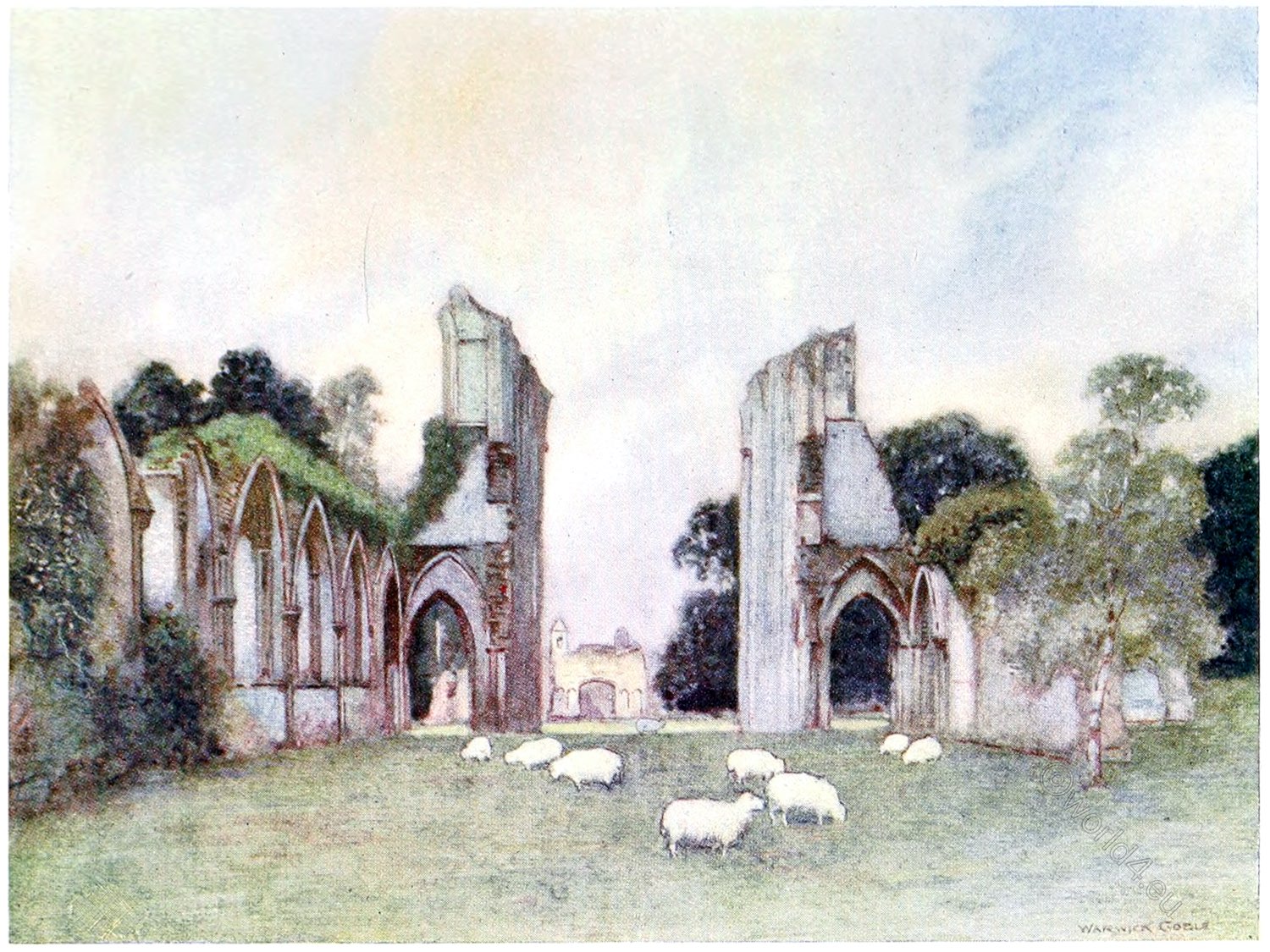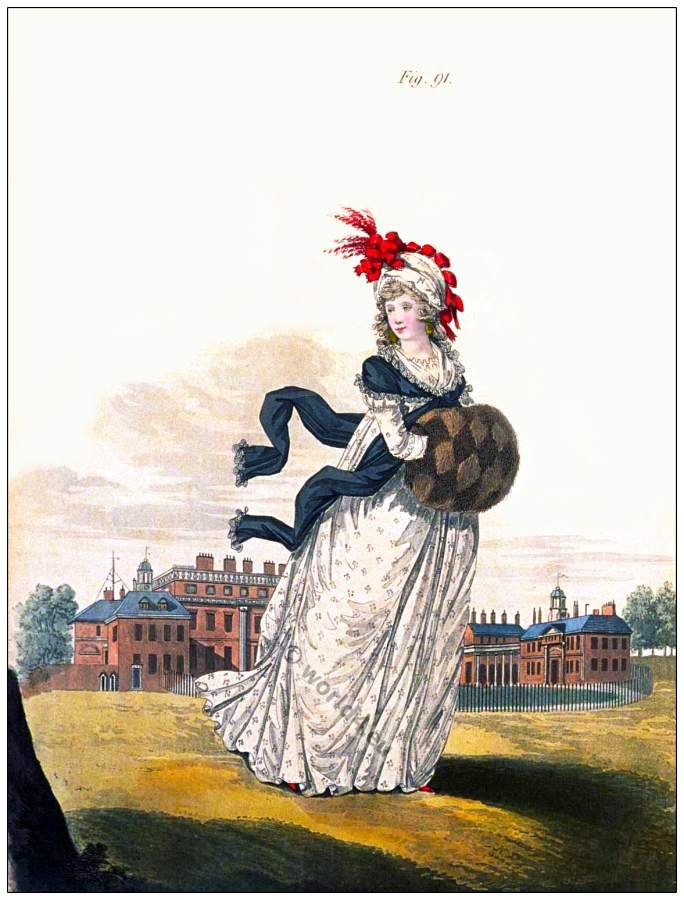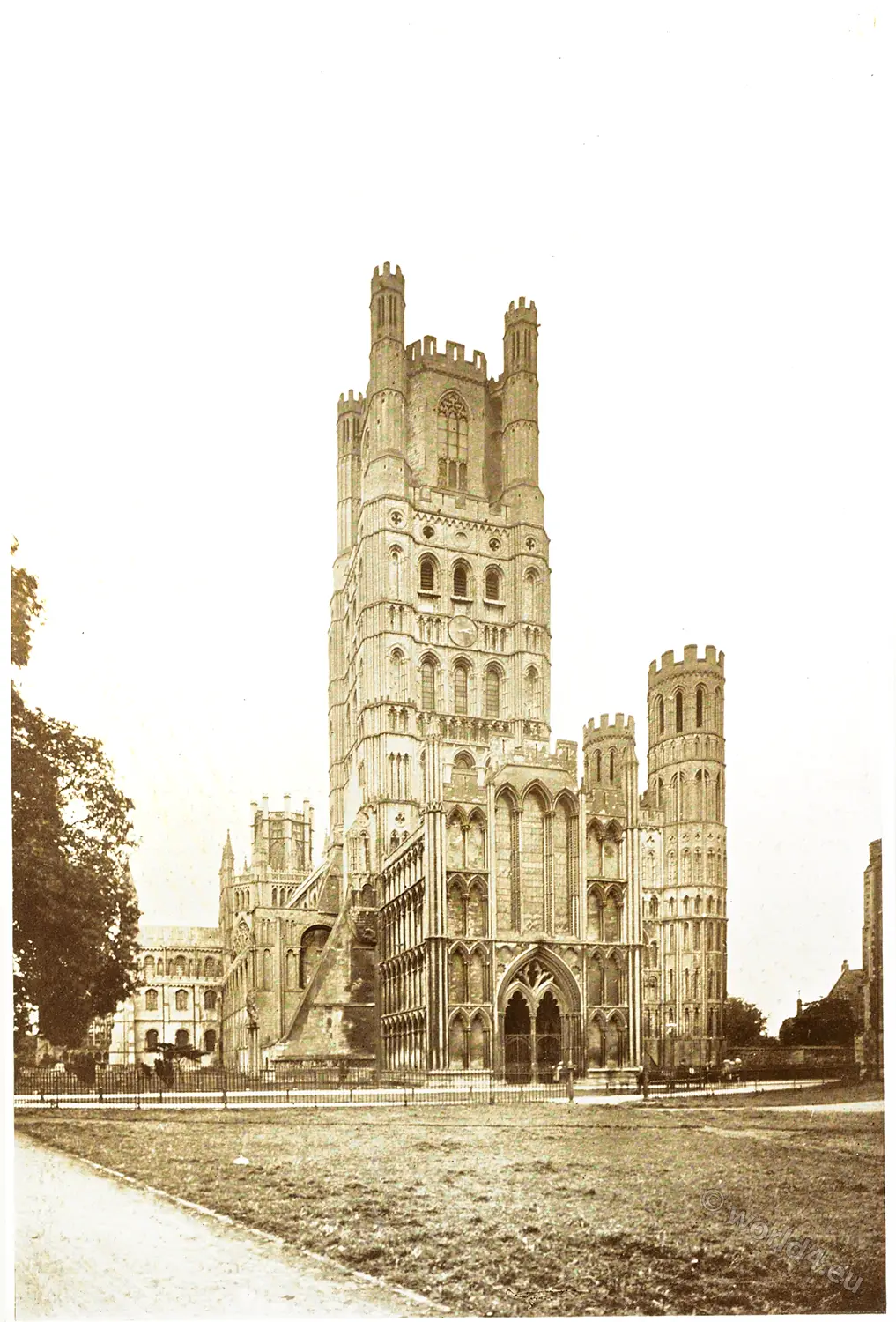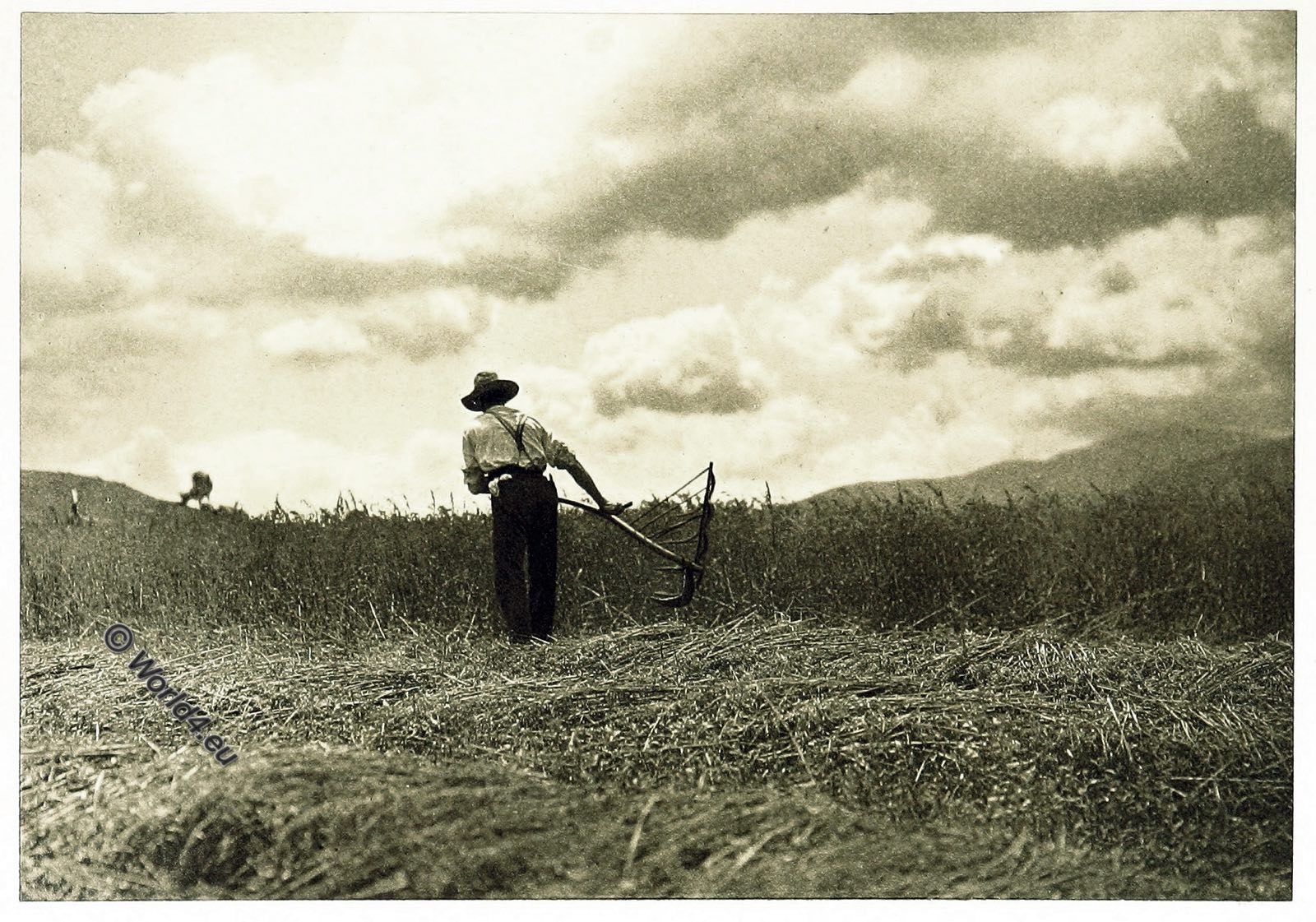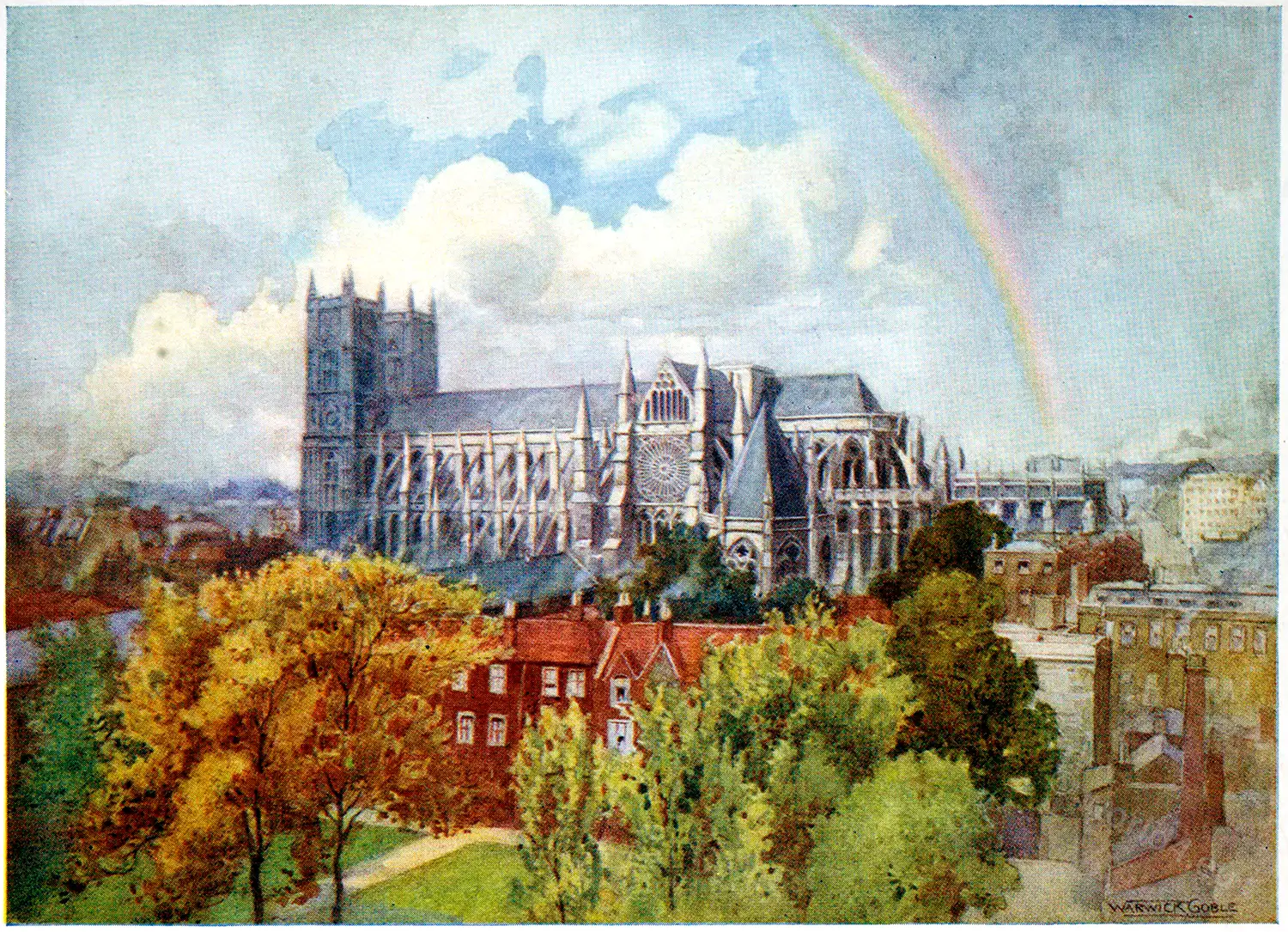Glastonbury Abbey is a former Benedictine abbey near Glastonbury in the county of Somerset, England south of Wells. There is no certain knowledge about the foundation of the monastery. According to traditional tradition, the foundation was already carried out by disciples of Jesus, an associated Christian settlement already existed in the 2nd century, Saints Patrick and David visited the monastery and the tombs discovered in 1191 are those of Arthur and Guinevere. Only in a later tradition was the name introduced by Joseph of Arimathea.
Glastonbury Abbey
THE name of Glastonbury carries the imagination far back into the dim past. The few scattered and grass-grown ruins, which now alone remain of the once vast pile of buildings, mark the site of one of the most renowned sanctuaries of the Christian world.
The history of this sacred spot goes back to days before the age of written records, for it is founded upon legends which connect it even with some of the first disciples of our Lord Himself. The story of the place is told in song and prose, in fact and fiction, in the legends and in the chronicles, which relate the beginnings of the English people. It opens with a vision of a venerable man from the tomb of Christ, bearing with him the Holy Grail, the chalice of his Master’s Supper, and planting in the soil of Somerset his staff cut from some Eastern thorn. Tennyson thus alludes to this ancient legend:
The cup, the cup itself from which our Lord
Drank at the last sad Supper with his own.
This from the blessed land of Aramat,
After the day of darkness, when the dead
Went wandering over Moriah — the good Saint
Arimathaean Joseph, journeying brought
To Glastonbury, where the winter thorn
Blossoms at Christmas, mindful of our Lord.
And the long story of the place ends in the sixteenth century with the violent and ignominious death of an old white-haired monk, the last of a long and honourable succession of abbots, by order of an English king in the evil days of Tudor despotism.
Between St Joseph of Arimathea, the hero of Glastonbury’s earliest legend, and Abbot Richard Whiting, the victim of an English king’s rapacity, the space of well-nigh fifteen centuries intervened; and Chalice Hill and Tor Hill, which still look down upon the ruins, and the very names of which are associated with him who brought the Holy Grail to our shores, and with him whose gallows crowned the height by St Michael’s tower, have been silent witnesses during all those centuries of a great and varied history.
The memories of the British Inyswytryn, the Saxon Glaestingburge, the modern Glastonbury, or as it was sometimes called the isle of Avalon, include the names of Arthur, the British hero, and of Alfred, the saviour of the Saxon race from the ferocity and rapacity of the Danes. Hither too came Gildas, from his hermitage on the Steep Holme away across the waters of the Channel, to reconcile Arthur to his Queen Guinevere. And hither also:
To the island-valley of Avilion;
Where falls not hail, or rain or any snow.
Nor even wind blows loudly; but it lies
Deep-meadow’d, happy, fair with orchard lawns
And bowery hollows, crown’d with summer sea.
Hither came Arthur, when wounded in the battle of Camlin, to die and seek for burial by the side of his Queen, who had already been laid to rest within the precincts of that Sanctuary. Here, centuries later, in 1191, King Henry II caused to be made an examination of the spot pointed out by the Welsh bards as the place of Arthur’s burial, and Giraldus Cambrensis, who professes to have been an eyewitness, describes the finding of a large flat stone with a leaden cross underneath, bearing in rude characters the inscription: Hic jacet sepultus inclitus rex Arturius in insula Avalonia.
Beneath this again there was discovered a large coffin of hollowed oak with two cavities, one containing the bones of Arthur, the other those of Guinevere. They were removed to a handsome tomb in the church, where they remained undisturbed till 1278, when Edward I and his Queen, Eleanor, kept Easter at the abbey. On that occasion the King desiring to see with his own eyes the relics of the illustrious British King and his Consort, ordered the tomb to be opened. Edward himself took out the relics of Arthur; carrying these, and Eleanor those of Guinevere, with much ceremony they bore them to the High Altar, where the people were allowed to inspect them.
In fact Glastonbury was already old in its traditions, and its memory was venerable in its legends before the Briton gave place to the Saxon. When, some time about the year 650, the shrine passed into the hands of the Saxon conqueror, these later were no longer pagan idolaters but Christian warriors, who venerated the sacred traditions of the spot no less than had the conquered Britons.
One relic of this early time was preserved through the course of the centuries even until the destruction of the monastery in the days of Henry VIII. According to tradition, St David of Menevia came to Inyswytryn, as Glastonbury was called in British times, bringing with him precious gifts and offerings and, it is said, anxious to make the sanctuary his last resting-place.
To show his veneration he proposed to dedicate the church to our Blessed Lady, but was admonished in a dream of the supernatural consecration of the shrine at its first erection. St David thereupon built a second church near to the ancient wooden one, and dedicated it to the Mother of God. To this sacred place he made an offering of a rich altar stone of sapphire adorned with gold and costly gems, a present from the Patriarch of Jerusalem, and this precious gift survived to the end in the possession of the Abbey.
During the contests between Saxon and Dane, which caused such havoc and destruction throughout the length and breadth of the land, this “Sapphire altar” was concealed, and for a time its hiding-place appears to have been forgotten. Subsequently, however, the stone was discovered in a recess of the old church, and it appears as one of the abbey’s most treasured possessions in the inventory drawn up by the commissioners appointed by Henry VIII to seize the property of the abbey in 1539.
“Item,” it is recorded, “delyvered unto his majestic . . . a superatare garnished with silver and gilt, called the Great saphire of Glasgonburge.”
During the Saxon period the abbey increased in renown and in influence: it became indeed the centre of Christianity in southern and western England. Although we have little direct proof of the fact, it seems almost certain that wandering Irish scholars came over to Glastonbury, tarried and taught there for a while, and departing left behind them their books and treatises to be the treasured possessions of future generations cf scholars.
The sanctuary, probably by reason of its position, escaped complete destruction at the hands of the Danes, who passed over the country wrecking and plundering monasteries and churches and overthrowing the Christian altars. It suffered, however, greatly: and it was at this period, at the lowest depth of his ill-fortune, that King Alfred sought shelter in the neighbourhood and, at least according to legend, found strength and courage to make his successful stand against the dreaded Dane in a vision which came to him in the sanctuary at Glastonbury.
In the tenth century the abbey was ruled by one who not only shed a glory over it by the holiness of his life and by his abilities, but who was also called upon to shape the destinies of his country. This was the celebrated St Dunstan, who, born almost under the shadow of the monastery, in his youth became a monk there. He subsequently as abbot did much to rebuild the walls of the sanctuary, and to implant in the of his brethren a love for the true principles of the Benedictine method of life. For a while Dunstan, destined for a more extended sphere of usefulness, found peace and true happiness in the secluded cloister life at Glastonbury.
His biographers picture him for us as sitting in the corridors of the abbey with the brethren; as walking with a companion about the enclosure leaning on a staff; as visiting the cells and offices to see that all was in order; as superintending the building and ornamentation of the abbey which under his care was then rising from its ruins; as even personally watching over the arrangements of the kitchen and other domestic concerns; or as rising before the day had dawned to copy, study or revise the manuscripts of his house, or to kneel motionless in the church with hands lifted heavenwards and face moist with tears. All agree in describing his kindly genial demeanour to others, his gentle yet firm method of teaching and his special love for boys.
After a period of perhaps fifteen years spent in his beloved home at Glastonbury, and in his bestloved occupations of the cloistered life, Dunstan became Bishop of Winchester, and then Archbishop of Canterbury. But amidst all the occupations for Church and State which engrossed the greater part of his life, he never forgot his monastic home, and his name has ever been irrevocably associated with Glastonbury.
During the closing period of the struggle between Saxon and Dane in England, in the first decades of the eleventh century, the sanctuary was honoured by the monarchs of both dynasties. Edmund Ironside enriched the abbey with land and possessions and when, after valiant though vain struggles, he died for his Saxon fatherland, his body was laid to rest in the spot he had chosen for his tomb in St Dunstan’s Church.
To Glastonbury also in 1030 came King Canute, his Danish successor: and here, after confirming every gift and privilege granted to the place by his Saxon predecessors, he knelt in prayer at the tomb of his rival and spread over it a covering enriched with the embroidery of skilled Saxon ladies. Ten years later King Hardicanute testified his devotion to the hallowed spot by the present of a superb shrine to hold the relics of St Benignus.
The Norman Conquest brought difficulties in the government of the house. It was part of the Conqueror’s policy to replace Saxon bishops and abbots by Norman prelates wherever this could be done. So here, at Glastonbury, the Saxon abbot Ailnoth was made to give place to the Norman Thurstan. Ailnoth and several of the monks of his house were interred by Lanfranc’s order at Canterbury and at the same time a not inconsiderable portion of the monastic estate was distributed amongst the foreign followers of William.
The imposition of Norman superiors over them must obviously have been everywhere distasteful to the English monks. The very presence in their midst of an alien abbot was a standing reminder of the fallen fortunes of the English race; and in the case of Glastonbury this not unnatural resentment was aggravated by the imperious temper and inconsiderate disposition of the individual chosen by the King to rule them, and by his determination to uproot all old English customs and traditions, in order to impose upon them what at least the monks considered to be new-fangled Norman notions of monasticism.
An attempt made to force the Glastonbury monks to adopt the chant of one William of Fescamp in place of what they had been accustomed to, and which rightly or wrongly they regarded as the music they had received from Rome itself, led to a refusal of the monks to obey in this matter.
Abbot Thurstan sent for armed laymen into the Chapter House to coerce them by a show of force. The monks took refuge in the church, out of which the abbot’s armed men strove to drag them. This at first failed, and the monks took refuge in the sanctuary, only to be fired upon by the arrows of the Frenchmen. In the end the laymen rushed in and regardless of the sanctity of the place “slew some of the monks and wounded many more, so that blood ran down from the altar on to the steps, and from the steps to the floor.” “Three,” adds the chronicle, “were smitten to death and eighteen wounded.”
The horror caused by this scandal led to the removal of Abbot Thurstan by order of William the Conqueror; and for a time there was peace. The Norman abbot, however, abided his time at Caen, and taking advantage of King Rufus’s empty coffers, he offered that monarch 500 pounds of silver for permission to return to Glastonbury. His reappearance immediately brought on fresh disturbances. Many of the monks sought shelter in neighbouring monasteries, and did not return until the appointment of Herlewyn on Thurstan’s death.
In 1126 Henry of Blois, the nephew of King Henry I, became abbot of Glastonbury, and although he was made Bishop of Winchester after only three years of rule, he obtained leave to retain the emoluments of his abbacy. He lived to enjoy these revenues for forty-five years, but in the main he spent them upon the reconstruction of the church and monastery. Adam of Domerham,the chronicler of the house, records that “he built the bell tower, the Chapter House, cloister, lavatory, refectory and dormitory; also the infirmary with its chapel; a splendid large palace; a spacious gateway, remarkable for its squared stones; a large brewhouse, and stables for many horses.” These he erected right from the foundation to their completion, and over and “besides these works he gave many princely ornaments to the Church.”
King Henry II refused to allow the monks to elect a superior on the death of Bishop de Blois, but sent an official to manage the monastic revenues, which he kept in his own hands. During this time, and, indeed, not very long after the death of the bishop, a fire destroyed most of the monastic buildings. This happened in 1184, and the old monastic chronicler thus bemoans the disaster: “In the following summer, that is to say on St Urban’s day [May 25, 1184], the whole of the monastery, except a chamber constructed in the Chapel by Abbot Robert, into which the monks afterwards betook themselves, and the bell-tower built by Bishop Henry, was consumed by fire.
The beautiful buildings lately erected by Henry of Blois and the Church, a place so venerated by all and the shelter of so many saints, were reduced to ashes. What sorrow was suffered! What groans arose! What tears were shed as the monks saw what had taken place, and pondered over the losses they had suffered. Their precious treasures, not only the gold and silver, but the stuffs and silks, the books and other ecclesiastical ornaments were thrown into a state of confusion which must bring tears to the eyes even of those who far away do but hear of these things.”
King Henry II, determined to restore Glastonbury out of the monastic revenues which he still kept in his hands, and which were administered by the King’s official, Fitz Stephen. In the royal charter granted in 1184 Henry says: “I, laying the foundation of the church at Glastonbury, which was reduced to ashes whilst it was in my hands, have determined to repair it either by myself or my heirs.” Up to the time of the fire the old church or lady chapel had remained, as originally built, a wooden structure. According to a tradition in the place, St Paulinus had not dared to touch what even in his day was regarded as a most sacred monument of antiquity, and to preserve it had cased it in boards lined with lead.
When, in 708, Ina King of Wessex had granted his charter of privileges to the abbey, in order to render the act more solemn, he signed it in the lignea Basilica, which, following the advice of St Aldhelm, he refrained from attempting even to beautify.
This cherished relic of antiquity was totally destroyed by the fire of 1184, and upon the site of the old wooden structure was built the present lady chapel, now often miscalled “St Joseph’s Chapel.” This beautiful specimen of thirteenth-century Gothic architecture was finished in 1216, and the chronicler, Adam de Domerham, thus records the fact: “He (King Henry II) completed the church of squared stones of the most splendid work, in the place where from the beginning the old church had stood, sparing nothing that could add to its ornamentation.”
The greater church, dedicated to SS. Peter and Paul, was only beginning to rise from its ashes when Henry died. This delayed the progress of reconstruction, and the vast building of which only a very inadequate idea may be formed by the ivy-grown arcaded walls, the pointed windows and great piers, which lift two portions of a springing keyless arch skyward, was carried out by a succession of abbots during the thirteenth and fourteenth centuries. “Standing on the green-sward in the centre of the nave, in front of the ruins of the great arch,” says a modern writer, ” the eye cannot help filling in the missing structure.
Three other great arches rise up to join their survivor, and to support the vaulting of the central tower, the transepts with triforium and clerestory branch off right and left, through the screen with its rood” and Mary and John, “the vista of the choir converges on the High Altar and reredos, upon which the mellow light of the windows beyond cast soft blended colour.
The twenty pillars of the nave lift up their arches to the arcading of the triforium, from which springs the decorated groining of the roof; tracery and moulding, panel and shaft, colour and gold, tomb and brass fill in the picture; surely these are mailed knights kneeling, and sturdy burghers, and women in homespun, and arch-eyed children scattered over the glistening tiles of the pavement; the hooded monks glide in, the sanctuary glitters with silk and embroidery, the organ rolls its echoes through the arches, chasing the fumes of the incense. A sudden hush, and the reverie has ended, and you stand, with the blue sky above, on the soft greensward of the nave leading up grass-green steps to the soft sward of the sanctuary, and the great arch looks down on you while ivy and shrub cling to their foot-hold in its mouldings and crumbling masonry.”
If the reconstruction of the church of Glastonbury after the fire went on slowly enough during the two hundred years that followed the catastrophe, the abbots who ruled the destinies of the abbey during that period and after, vie with one another in collecting plate and jewels, missals and choir-books, vestments and copes and hangings with which to render the ceremonial at Glastonbury more worthy of the worship carried out within the newly built-up walls, and to make the place resplendent with all that art and skill and English craft could produce. As one reads the lists of precious gifts and cunningly fashioned plate, of the silks and brocades embroidered by English artists and enriched with needlework imagery and ornament, one can but sigh to think of the wanton destruction which swept away all these art treasures without leaving even a trace of a collection which must have been second to none of the ecclesiastical treasuries of Europe.
The end came to the glories of Glastonbury as it came to the rest of the monastic establishments in the reign of Henry VIII. On a charge of resisting the King’s desires, the venerable abbot, Richard Whiting, doomed to death before inquiry, was hanged with two of his brethren on the hill which still overlooks the ruins of this once-famous abbey.
Source: The greater abbeys of England by Cardinal Francis Aidan Gasquet, Francis Aidan (1846-1929). London: Chatto & Windus, 1908.

Related
Discover more from World4 Costume Culture History
Subscribe to get the latest posts sent to your email.

